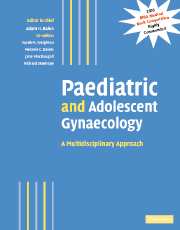Book contents
- Frontmatter
- Contents
- Contributors
- Preface
- Part I Normal development
- Part II Management of developmental abnormalities of the genital tract
- 9 Management of ambiguous genitalia at birth
- 10 Imaging of the female pelvis in the evaluation of developmental anomalies
- 11 Surgical correction of vaginal and other anomalies
- 12 Laparoscopic techniques
- 13 A nonsurgical approach to the treatment of vaginal agenesis
- 14 Psychological care in disorders of sexual differentiation and determination
- 15 The needs of the adolescent patient and her parents in the clinic
- 16 Communicating a diagnosis
- 17 Patients and parents in decision making and management
- Part III Management of specific disorders
- Index
- Plate section
- References
13 - A nonsurgical approach to the treatment of vaginal agenesis
from Part II - Management of developmental abnormalities of the genital tract
Published online by Cambridge University Press: 04 May 2010
- Frontmatter
- Contents
- Contributors
- Preface
- Part I Normal development
- Part II Management of developmental abnormalities of the genital tract
- 9 Management of ambiguous genitalia at birth
- 10 Imaging of the female pelvis in the evaluation of developmental anomalies
- 11 Surgical correction of vaginal and other anomalies
- 12 Laparoscopic techniques
- 13 A nonsurgical approach to the treatment of vaginal agenesis
- 14 Psychological care in disorders of sexual differentiation and determination
- 15 The needs of the adolescent patient and her parents in the clinic
- 16 Communicating a diagnosis
- 17 Patients and parents in decision making and management
- Part III Management of specific disorders
- Index
- Plate section
- References
Summary
Introduction
Vaginal dilator pressure treatment is a nonsurgical treatment method to extend or create a vagina for patients with vaginal agenesis. In this chapter, the term dilation is used to describe the extension of width and length of the vaginal pit (dilatation). The dilator is a cylindrical instrument of moulded plastic, which is repeatedly applied with pressure. Treatment to develop a short or absent vagina is offered to women who desire the capacity for sexual activity that includes sexual intercourse or other vaginal penetration. Dilation treatment relies upon patient adherence and, therefore, requires a scrupulous patient-centred approach by the multidisciplinary team.
History of dilation
Since the first descriptions of congenital absence of the vagina, physicians have described and performed various techniques for the creation of a neovagina in order that women can achieve sexual function including vaginal penetration. Frank was the first to describe treating young women with vaginal agenesis using a vaginal pressure dilation technique (Frank, 1938). He reported the treatment of six patients using vaginal dilators. Dilation treatment occurred two to three times per day and dilators were placed in the vagina throughout the night. Frank reported that five of his patients achieved a vaginal length of 6.5–7 cm within six to eight weeks of treatment and three of the women had sexual intercourse after treatment.
Since Frank detailed his method, there have been variations of his pressure dilation technique.
- Type
- Chapter
- Information
- Paediatric and Adolescent GynaecologyA Multidisciplinary Approach, pp. 147 - 157Publisher: Cambridge University PressPrint publication year: 2004
References
- 2
- Cited by



